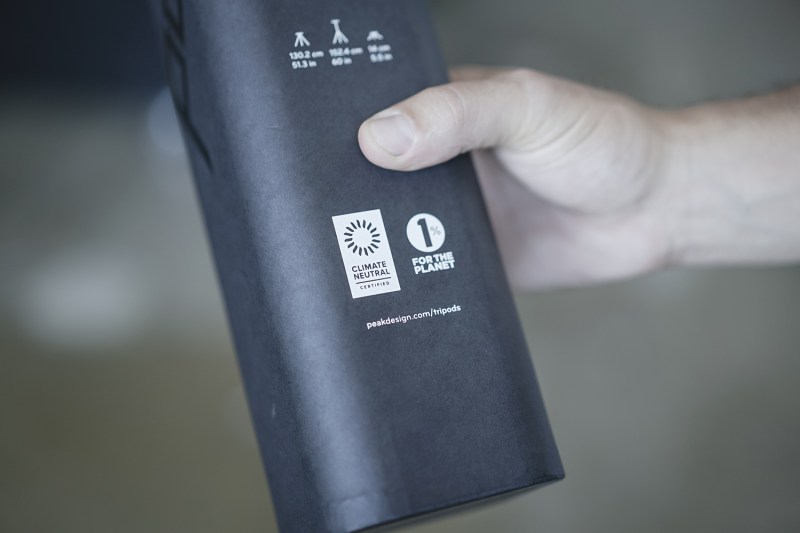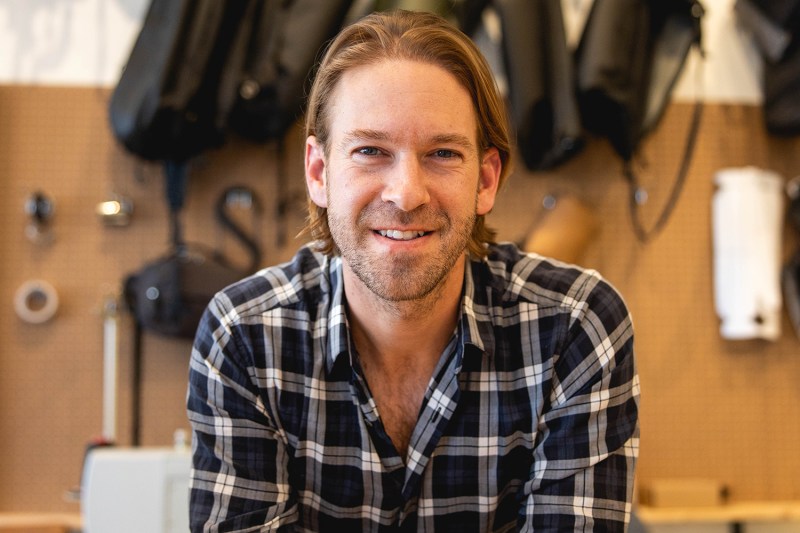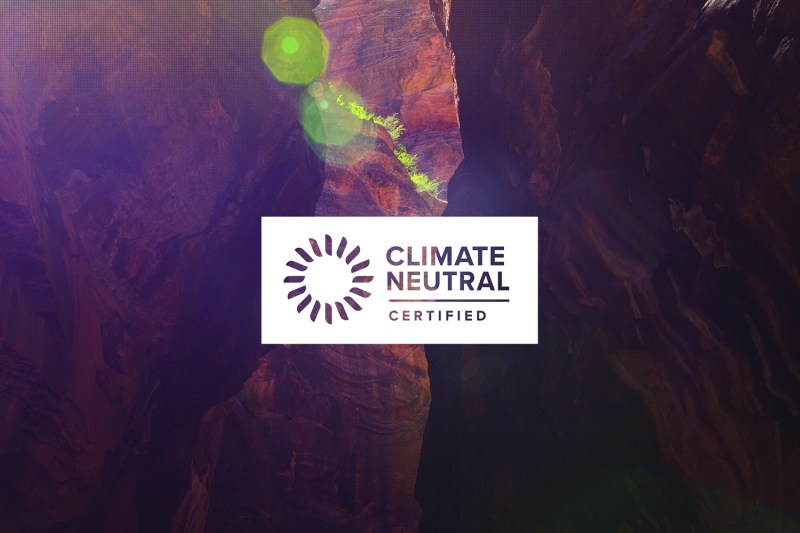Many brands talk about reducing their environmental footprint and becoming climate or carbon neutral. But what does that mean and how many companies actually do it?
Sure, we’ve got algae shirts, electric adventure vehicles, and 100% recycled clothing here and there, but to create those products, aren’t we still pumping carbon into the atmosphere? And those are just a few examples from the outdoor industry. Most businesses are trying hard to get you to buy new junk every season: “Throw your old stuff in the garbage and buy our new line.”
At the end of the day, what impact does that have on our wild areas, trees, animals, and ocean? Are we warming ourselves out of a planet by making more things to buy?
The founders of Climate Neutral are fed up with talking about saving the environment and are actually doing something about it.
What Is Climate Neutral?
Climate Neutral is a new non-profit born from the innovative and caring minds of Peak Design founder Peter Dering and BioLite founder Jonathon Cedar. Both companies have a knack for breaking problems down to their simplest forms and coming up with unique solutions. While reducing carbon in the atmosphere or putting a price on emissions is not new, they’ve organized it in a beautiful way and made it easy to understand.
The whole process is based around a company’s carbon footprint, or the amount of greenhouses gases it’s putting into the atmosphere.

How Does Climate Neutral Work?
Climate Neutral is for companies and businesses. Any business can join the nonprofit, and once they do, they commit to doing four things:
- Measure
- Reduce
- Offset
- Label
There’s a lot going on in each of the four steps but when you boil it down, this is it:
Measure
Step No. 1 is measuring. Nothing can be done until a company knows its total greenhouse gas emissions. The key here is measuring all emissions from raw material extraction to delivery and transportation to the customer. This also includes things like employee air travel, commuting to the office, and the energy used to run the buildings. Each of these falls under a category called Scope 1, 2, and 3:
- Scope 1 is direct emissions from on-site facilities and employee commuting. Some companies only measure this scope, when in reality, their emissions go far beyond the most obvious.
- Scope 2 is indirect emissions generated off-site from powering operations. For example, solar power will have a much smaller footprint in this section than a coal plant.
- Scope 3 is the hardest to measure and includes indirect emissions from the supply chain. What is the carbon footprint of all your raw materials? Where did they come from and how did they get out of the ground? Using recycled materials can reduce the footprint here.
Currently, the process of measuring can be a major hurdle to becoming carbon-neutral. Both Peak Design and BioLite hired independent firms to footprint their operations. To make it easier for other companies, Carbon Neutral is building a tool to easily and accurately estimate carbon emissions. Once complete, they’ll be able to footprint a business for Climate Neutral certification in less than a week.
Reduce
Step No. 2 in the process is making a reduction plan. We’re not going to survive on this planet if everyone just buys carbon offsets. There has to be a plan to reduce emissions. Every certified company will commit to two reduction actions every year.
Offset
Once a reduction plan is in place, it’s time to offset the emissions from the previous year. All these activities have to be finished before April 22 (Earth Day). For example, companies certifying for 2020 will be measuring emissions during 2019.
Offset projects can be as simple as planting trees. Others capture gas emissions from landfills or reduce tilling of the soil during farming. Climate Neutral works with third-party vendors to make sure the offsets are from official sources and scientifically validated.
Label
Going to all this trouble without telling anyone would be a shame. One of the goals of the nonprofit is to make the Climate Neutral Certified label standard across all industries. Preferring to buy Carbon Neutral Certified-products will promote companies that fund renewable energy and reforestation projects. If your favorite brand is producing jackets or shoes with twice the carbon footprint, then maybe it’s time to switch.
More than 50 brands have committed to certifying Climate Neutral, including Allbirds, Kickstarter, Lifestraw, and Klean Kanteen.
Interview with Peter Dering
We caught up with Peak Design and Climate Neutral co-founder Peter Dering to learn more about the process and where he thinks it’s heading in the future.

The Manual: Peak Design seems to have a very good design process for products. Where does that process come from and is it harder to do than just a normal process? Did that come into play when designing Climate Neutral and the idea for the label?
Peter Dering: Good question. If anything is unique about our process at Peak Design, I’d wager a guess that it’s because it’s, shall we say, homegrown. When I started Peak Design, I had been a construction engineer with zero experience in product design. Art Viger, who’s now our lead designer (and has been since 2012) had a degree in product design but was bartending when I found him. He’d never made a product either. We didn’t start hiring people who’d designed products professionally until four years after the birth of the company, and that hire was Robb Jankura. Robb led engineering at Specialized for their mountain bikes division, but he quit at least in part because there was too much process. He found our relatively unstructured process refreshing.
Process is something that always evolves over time, and as we grow, we’re seeing it define itself more systematically at Peak. What remains, however, is a strong commitment to launching things only when they’re ready. This means deadlines shift, and the rest of the company — and the customers, frankly — need to know that this is part of the deal.
For me, the most important thing in 2020 is that we crack the nut of how to measure a company’s entire carbon footprint with as little effort as possible. That means striking the right balance between the precision of the measurement and the expedience of gathering it.
I suppose Climate Neutral is defining its process in similar ways. However, with Climate Neutral, our CEO Austin Whitman has more of a say over how that organization is defined. And I think that’s a good thing. Austin is much more of an adult than I am, and that’s critical when you’re developing a certification that depends on very serious people, well, taking it seriously.
TM: What’s your goal for certifications for 2020 and 2021?
PD: For me, the most important thing in 2020 is that we crack the nut of how to measure a company’s entire carbon footprint with as little effort as possible. That means striking the right balance between the precision of the measurement and the expedience of gathering it. Both are critical, but they are on opposite sides of the spectrum. Make it too imprecise, and it will lack credibility. Make it too onerous, and it will prevent people from participating. I want us to nail this sweet spot so that it can be the norm that companies are expected to go forth with.
TM: When will we see the label in stores?
PD: As soon as we ship those damn tripods. Although, actually, Peak Design has a product release scheduled for later in the month that will have the label. Other committed brands have plans to use it early in 2020 as well.

TM: Where does all the off-set money go? Can companies choose their projects?
PD: You bet. We set criteria that guide people toward verified offsets with certifications from Gold Standard, the Verified Carbon Standard (VCS), the Climate Action Reserve, the American Carbon Registry, and the Clean Development Mechanism (formed by the UN). Additionally, from within each one of those certified carbon credits, we limit the types of projects and the date of their creation. But so long as people meet the criteria we’ve set up, they can source their own offsets.
TM: How has Peak Design reduced their emissions?
PD: The biggest thing we’ve done is [we] worked really hard to use recycled aluminum in every place we can. For now, this represents all of our die-cast parts. We’re still working on the formula to use them on our anodized parts. This is trickier, as there are inherently more impurities in recycled aluminum, and if a surface is converted (i.e., anodization) instead of painted (in the case of die-cast parts), it’s harder to get the right alloy.
We’ve also switched to recycled fabrics for the majority of the textiles we use, and I think most importantly, are solution dying most of the colorways in our upcoming line of bags, which uses far less water and energy. We’ve slimmed down our packaging, particularly for bags, which creates the lowest carbon footprint. Counter to conventional wisdom, that means using a plastic bag. We’ve been quiet about these changes because even though we do what is within our grasp, it amounts to very little. This is why offsets are critical.
Footprinting will, of course, vary depending on the complexity of a company’s operations. But the goal is for most companies to be able to have a rough footprint in a matter of hours, and a usable footprint for certifications in a week’s time.
TM: Is it going to be hard to get the massive companies on board?
PD: Without question, it will be hard. There are two types of companies in the massive group we’re talking about. There are those (very few) that are already committed to net zero carbon, and those that we are trying to convince to become net zero. The difficulty in the first group is convincing them that Climate Neutral has the credibility to warrant their involvement. With the second group, the credibility challenge is there, plus you’ve got to convince them to spend a significant amount of money on carbon reduction, and that might not appease their shareholders. It’s an uphill battle that will require consumers demanding that companies take responsibility for their carbon.
TM: How long does it take to footprint? And will it ever cost anything with Climate Neutral?
PD: Footprinting will, of course, vary depending on the complexity of a company’s operations. But the goal is for most companies to be able to have a rough footprint in a matter of hours, and a usable footprint for certifications in a week’s time. We hope that we can keep the cost at zero, but that will depend on whether we can find outside funding sources for our non-profit.
TM: Are companies going to run out of reduction methods? Is there a minimum size reduction they must meet each year?
PD: Companies will absolutely run out of reduction methods, particularly within their own operations. However, we anticipate that further reductions can and shall be achieved by chasing the supply chain upstream. Making suppliers purchase renewables is a fairly insatiable place for reductions to occur. Given the variability in companies, we don’t think it’s practical to mandate quantitative reductions, which is why we focus on qualitative reductions.

TM: I hear a lot of people saying, they want to do something but aren’t sure what. A clear process like this for individuals would be helpful. Is there anything for individuals yet? What do you recommend for that?
PD: For now at least, Climate Neutral is not going to put forth an individual certification, although that is on the soft roadmap for future years. I’d recommend people check out Joro, which links purchase data to a carbon footprint. It’s effective and has a great app interface.
TM: This seems like a simple, effective idea. Why has no one done this yet for carbon neutrality?
PD: The simple answer is, they have. There are actually quite a few certifications that have come and gone or are still around. I think the reasons they haven’t taken off several: in some cases, they are constrained to particular offset providers. Most are very complex on the measurement side, and thus prohibitive for companies to inject. I think several of them suffer from having been created during the first wave of cleantech, i.e. the early 2000s. So much wind was taken out of the sails by the economic slowdown of 2008 that they had trouble recovering.
Climate Neutral is simply the latest effort, but perhaps has a bigger push than any previous to it. We’re also differentiating ourselves by coming up with a measurement tool that is built by well-known brands with complex supply chains.
We’ll see if it works. We think we’re off to a great start.
Donating just $5 to the Climate Neutral Kickstarter will help make this certification a reality. Pledge $100 and that covers your personal offset for the year. The Kickstarter ends on December 12, 2019.


